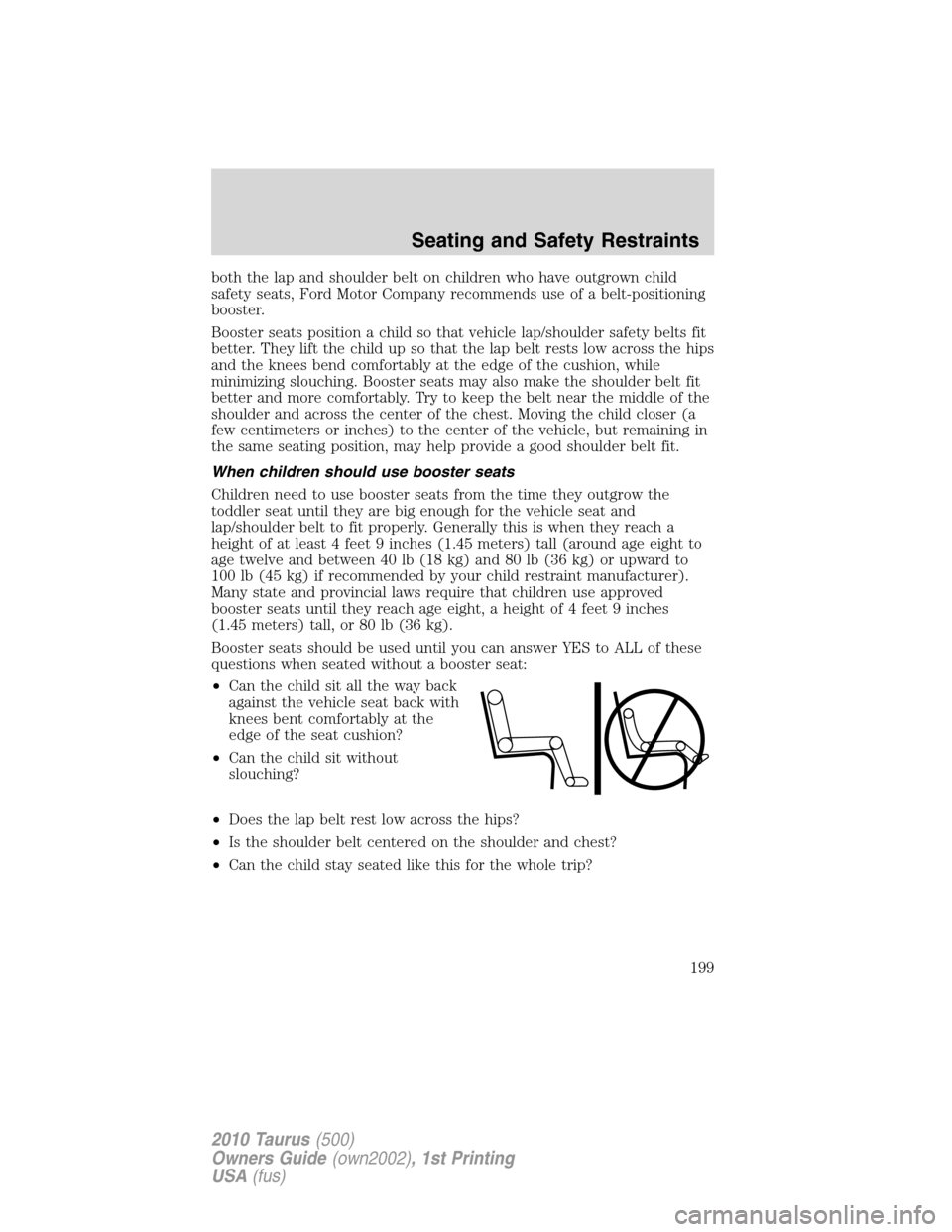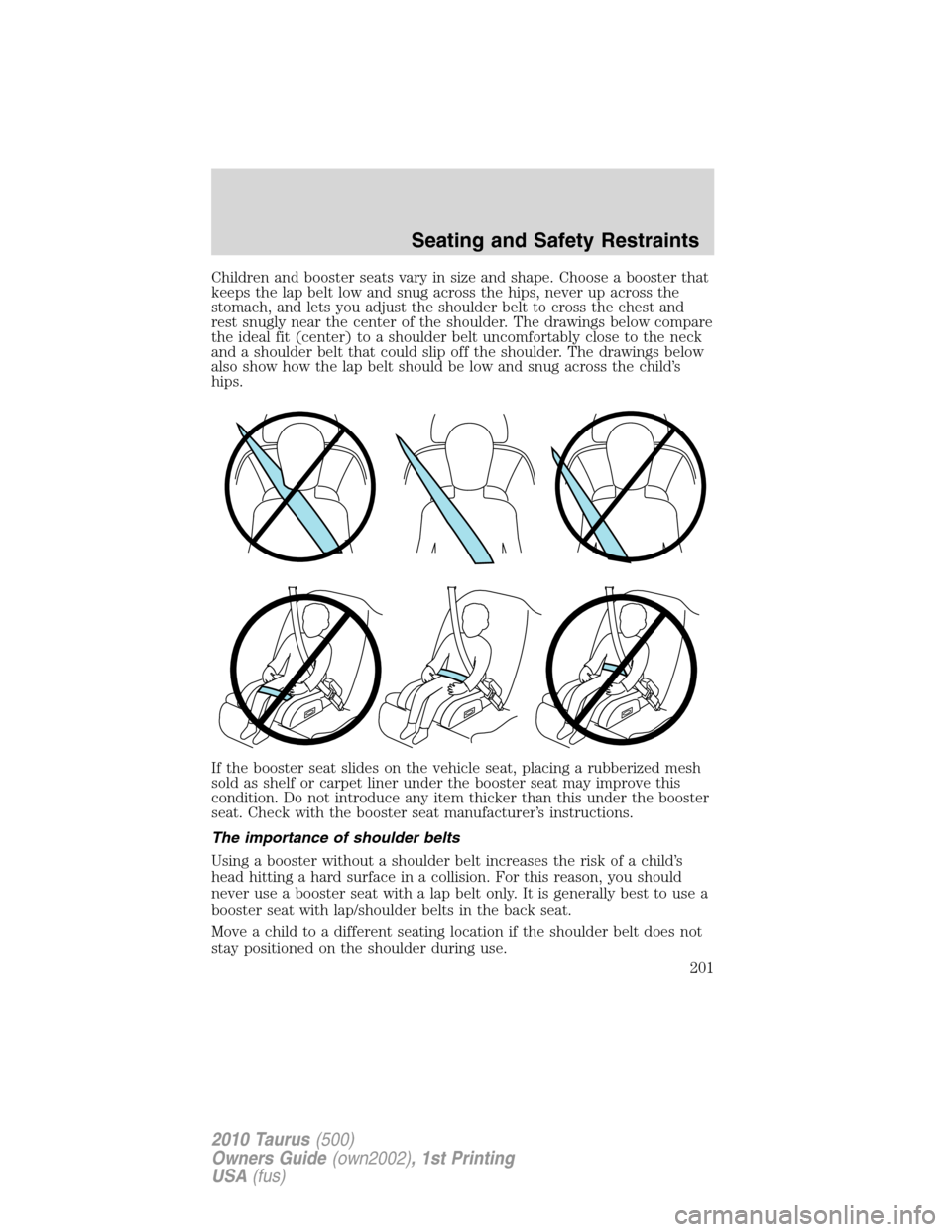Page 198 of 378

3. Open the tether anchor cover.
4. Clip the tether strap to the
anchor as shown.
If the tether strap is clipped
incorrectly, the child safety seat may
not be retained properly in the
event of a collision.
5. Tighten the child safety seat tether strap according to the
manufacturer’s instructions.
If the safety seat is not anchored properly, the risk of a child being
injured in a collision greatly increases.
If your child restraint system is equipped with a tether strap, and the
child restraint manufacturer recommends its use, Ford also recommends
its use.
Child booster seats
The belt-positioning booster (booster seat) is used to improve the fit of
the vehicle safety belt. Children outgrow a typical child seat (e.g.,
convertible or toddler seat) when they weigh about 40 lb (18 kg) and are
around four (4) years of age. Consult your child safety seat owner guide
for the weight, height, and age limits specific to your child safety seat.
Keep your child in the child safety seat if it properly fits the child,
remains appropriate for their weight, height and age AND if properly
secured to the vehicle.
Although the lap/shoulder belt will provide some protection, children
who have outgrown a typical child seat are still too small for lap/shoulder
belts to fit properly, and wearing an improperly fitted vehicle safety belt
could increase the risk of serious injury in a crash. To improve the fit of
Seating and Safety Restraints
198
2010 Taurus(500)
Owners Guide(own2002), 1st Printing
USA(fus)
Page 199 of 378

both the lap and shoulder belt on children who have outgrown child
safety seats, Ford Motor Company recommends use of a belt-positioning
booster.
Booster seats position a child so that vehicle lap/shoulder safety belts fit
better. They lift the child up so that the lap belt rests low across the hips
and the knees bend comfortably at the edge of the cushion, while
minimizing slouching. Booster seats may also make the shoulder belt fit
better and more comfortably. Try to keep the belt near the middle of the
shoulder and across the center of the chest. Moving the child closer (a
few centimeters or inches) to the center of the vehicle, but remaining in
the same seating position, may help provide a good shoulder belt fit.
When children should use booster seats
Children need to use booster seats from the time they outgrow the
toddler seat until they are big enough for the vehicle seat and
lap/shoulder belt to fit properly. Generally this is when they reach a
height of at least 4 feet 9 inches (1.45 meters) tall (around age eight to
age twelve and between 40 lb (18 kg) and 80 lb (36 kg) or upward to
100 lb (45 kg) if recommended by your child restraint manufacturer).
Many state and provincial laws require that children use approved
booster seats until they reach age eight, a height of 4 feet 9 inches
(1.45 meters) tall, or 80 lb (36 kg).
Booster seats should be used until you can answer YES to ALL of these
questions when seated without a booster seat:
•Can the child sit all the way back
against the vehicle seat back with
knees bent comfortably at the
edge of the seat cushion?
•Can the child sit without
slouching?
•Does the lap belt rest low across the hips?
•Is the shoulder belt centered on the shoulder and chest?
•Can the child stay seated like this for the whole trip?
Seating and Safety Restraints
199
2010 Taurus(500)
Owners Guide(own2002), 1st Printing
USA(fus)
Page 200 of 378
Types of booster seats
There are generally two types of belt-positioning booster seats: backless
and high back. Always use booster seats in conjunction with the vehicle
lap/shoulder belt.
•Backless booster seats
If your backless booster seat has a
removable shield, remove the
shield. If a vehicle seating position
has a low seat back or no head
restraint, a backless booster seat
may place your child’s head (as
measured at the tops of the ears)
above the top of the seat. In this
case, move the backless booster
to another seating position with a
higher seat back or head restraint and lap/shoulder belts, or consider
using a high back booster seat.
•High back booster seats
If, with a backless booster seat,
you cannot find a seating position
that adequately supports your
child’s head, a high back booster
seat would be a better choice.
Seating and Safety Restraints
200
2010 Taurus(500)
Owners Guide(own2002), 1st Printing
USA(fus)
Page 201 of 378

Children and booster seats vary in size and shape. Choose a booster that
keeps the lap belt low and snug across the hips, never up across the
stomach, and lets you adjust the shoulder belt to cross the chest and
rest snugly near the center of the shoulder. The drawings below compare
the ideal fit (center) to a shoulder belt uncomfortably close to the neck
and a shoulder belt that could slip off the shoulder. The drawings below
also show how the lap belt should be low and snug across the child’s
hips.
If the booster seat slides on the vehicle seat, placing a rubberized mesh
sold as shelf or carpet liner under the booster seat may improve this
condition. Do not introduce any item thicker than this under the booster
seat. Check with the booster seat manufacturer’s instructions.
The importance of shoulder belts
Using a booster without a shoulder belt increases the risk of a child’s
head hitting a hard surface in a collision. For this reason, you should
never use a booster seat with a lap belt only. It is generally best to use a
booster seat with lap/shoulder belts in the back seat.
Move a child to a different seating location if the shoulder belt does not
stay positioned on the shoulder during use.
Seating and Safety Restraints
201
2010 Taurus(500)
Owners Guide(own2002), 1st Printing
USA(fus)
Page 244 of 378

ADVANCETRAC�STABILITY ENHANCEMENT SYSTEM
WARNING:Vehicle modifications involving braking system,
aftermarket roof racks, suspension, steering system, tire
construction and/or wheel/tire size may change the handling
characteristics of the vehicle and may adversely affect the performance
of the AdvanceTrac�system. In addition, installing any stereo
loudspeakers may interfere with and adversely affect the AdvanceTrac�
system. Install any aftermarket stereo loudspeaker as far as possible
from the front center console, the tunnel, and the front seats in order
to minimize the risk of interfering with the AdvanceTrac�sensors.
Reducing the effectiveness of the AdvanceTrac�system could lead to
an increased risk of loss of vehicle control, vehicle rollover, personal
injury and death.
WARNING:Remember that even advanced technology cannot
defy the laws of physics. It’s always possible to lose control of a
vehicle due to inappropriate driver input for the conditions. Aggressive
driving on any road condition can cause you to lose control of your
vehicle increasing the risk of personal injury or property damage.
Activation of the AdvanceTrac�system is an indication that at least
some of the tires have exceeded their ability to grip the road; this
could reduce the operator’s ability to control the vehicle potentially
resulting in a loss of vehicle control, vehicle rollover, personal injury
and death. If your AdvanceTrac�system activates, SLOW DOWN.
WARNING:If a failure has been detected within the
AdvanceTrac�system, the�sliding car�icon
will illuminate
steadily, and you may hear a chime. If equipped with a message center,
the vehicle will also indicate a failure with the Brake system, have the
system serviced by an authorized dealer immediately. Operating your
vehicle with AdvanceTrac�disabled could lead to an increased risk of
loss of vehicle control, vehicle rollover, personal injury and death.
Your vehicle is equipped with the AdvanceTrac�system. The
AdvanceTrac�system provides the following stability enhancement
features for certain driving situations:
•Traction Control (TCS), which functions to help avoid drive-wheel
spin and loss of traction.
•Electronic Stability Control (ESC), which functions to help avoid skids
or lateral slides
Driving
244
2010 Taurus(500)
Owners Guide(own2002), 1st Printing
USA(fus)
Page 282 of 378

Fuse/Relay
LocationFuse Amp
RatingProtected Circuits
8 10A Low beam headlamps (right)
9 15A Interior lights, Cargo lamps
10 15A Switch illumination, Puddle lamps
11 10A All wheel drive (AWD) module
12 7.5A Passive entry/passive start (PEPS)
module
13 5A Memory seats, Mirrors, Keypad, PEPS
receiver, Driver’s door module
14 10A Navigation display, Memory seat,
SYNC�, Center information display,
GPS, Driver seat
15 10A Climate control
16 15A Electronic finish panel, Ambient
lighting
17 20A Trunk release, Moon roof, Smart
windows, Lock/unlock
18 20A Rear heated seats
19 25A Audio amplifier
20 15A Diagnostic connector (OBDII),
Adjustable pedal motor
21 15A Daytime running lamps (DRL) control
22 15A Park lamps, License plate lamps,
Auxiliary lamps
23 15A High beam headlamps
24 20A Horn
25 10A Demand lighting (battery saver)
26 10A Instrument panel cluster, Heads up
display
27 20A Ignition switch, PEPS, Front wipers,
One-touch integrated start (OTIS)
28 5A Start relay/Audio mute
Roadside Emergencies
282
2010 Taurus(500)
Owners Guide(own2002), 1st Printing
USA(fus)
Page 283 of 378

Fuse/Relay
LocationFuse Amp
RatingProtected Circuits
29 5A Instrument panel cluster, Heads up
display
30 5A Not used (spare)
31 10A Not used (spare)
32 10A Airbag module
33 10A Not used (spare)
34 5A Anti-lock brake system (ABS),
Electronic power steering
35 10A Rear heated seats, AWD, Rear park
assist, Steering angle sensor, Blind
spot information system,
Multi-contour seats
36 5A Passive anti-theft system (PATS)
37 10A Not used (spare)
38 20A Subwoofer, Speaker amplifier
39 20A Radio/navigation
40 20A Not used (spare)
41 15A Delayed accessory feeds
42 10A Not used (spare)
43 10A Rear window defroster, Front wipers,
Automatic high beam controller,
Rainsensor
44 10A Not used (spare)
45 5A Front wiper relay, Blower motor relay
46 7.5A Occupant classification sensor (OCS),
Passenger airbag deactivation
indicator (PADI)
47 30A Circuit
BreakerFront passenger power window, Rear
power windows
48 — Delayed accessory relay
Roadside Emergencies
283
2010 Taurus(500)
Owners Guide(own2002), 1st Printing
USA(fus)
Page 285 of 378
Fuse/Relay
LocationFuse Amp
RatingPower Circuits
3 — Not used
4 30A** Front wiper
5 30A** Passenger seat
6 20A** Cigar lighter
7 — Not used
8 30A** Moon roof
9 40A** Anti-lock brake system (ABS)
pump
10 30A** Starter relay
11 30A** Powertrain Control Module (PCM)
relay
12 20A** ABS valve
13 15A* Adaptive cruise control
14 — Not used
15 — Not used
16 20A* Left headlamp
17 10A* Alternator
18 — Not used
19 20A** Instrument panel power point
20 40A** Rear window defroster
21 20A** Console power point
22 30A** Front heated or heated/cooled
seats
23 7.5A* Powertrain control module (PCM)
(keep alive power), Canister vent
24 10A* A/C clutch
25 20A* Right headlamp
26 10A* Backup relay
27 25A* Fuel pump
28 80A** Engine cooling fan
29 — Not used
30 — Not used
Roadside Emergencies
285
2010 Taurus(500)
Owners Guide(own2002), 1st Printing
USA(fus)